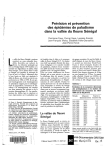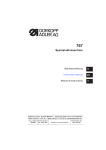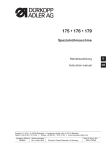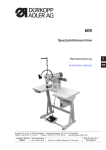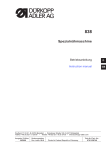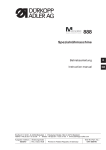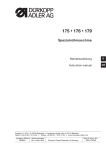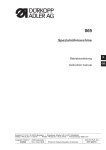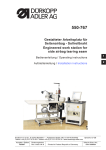Download Duerkopp Adler 767 Instruction manual
Transcript
767 Spezialnähmaschine Betriebsanleitung D Instruction manual GB Manuel d'instructions Postfach 17 03 51, D-33703 Bielefeld • Potsdamer Straße 190, D-33719 Bielefeld Telefon +49 (0) 5 21 / 9 25- 00 • Telefax +49 (0) 5 21 / 9 25 24 35 • www.duerkopp-adler.com Ausg. / Edition: Änderungsindex 10/2008 Rev. index: 03.0 Printed in the Czech Republic Teile-Nr./Part.-No.: 0791 767742 F Alle Rechte vorbehalten. Eigentum der Dürkopp Adler AG und urheberrechtlich geschützt. Jede, auch auszugsweise Wiederverwendung dieser Inhalte ist verboten. All rights reserved. Property of the Dürkopp Adler AG and copyrighted. Reproduction or publication of the content in any manner, without express permission of the publisher, is prohibited. Tous droits réservés. Propriété de la société Dürkopp Adler AG et protégé par la loi sur le droit d’auteur. Une copie ou reproductionpar quelque procédé que ce soit du contenu sans accord écrite de l’auteur est interdite. Copyright ã 2008 - Dürkopp Adler AG Foreword This instruction manual is intended to help the user to become familiar with the machine and take advantage of its application possibilities in accordance with the recommendations. The instruction manual contains important information on how to operate the machine securely, properly and economically. Observation of the instructions eliminates danger, reduces costs for repair and down-times, and increases the reliability and life of the machine. The instruction manual is intended to complement existing national accident prevention and environment protection regulations. The instruction manual must always be available at the machine/sewing unit. The instruction manual must be read and applied by any person that is authorized to work on the machine/sewing unit. This means: – – – Operation, including equipping, troubleshooting during the work cycle, removing of fabric waste, Service (maintenance, inspection, repair) and/or Transport. The user also has to assure that only authorized personnel work on the machine. The user is obliged to check the machine at least once per shift for apparent damages and to immediatly report any changes (including the performance in service), which impair the safety. The user company must ensure that the machine is only operated in perfect working order. Never remove or disable any safety devices. If safety devices need to be removed for equipping, repairing or maintaining, the safety devices must be remounted directly after completion of the maintenance and repair work. Unauthorized modification of the machine rules out liability of the manufacturer for damage resulting from this. Observe all safety and danger recommendations on the machine/unit! The yellow-and-black striped surfaces designate permanend danger areas, eg danger of squashing, cutting, shearing or collision. Besides the recommendations in this instruction manual also observe the general safety and accident prevention regulations! General safety instructions The non-observance of the following safety instructions can cause bodily injuries or damages to the machine. 1. The machine must only be commissioned in full knowledge of the instruction book and operated by persons with appropriate training. 2. Before putting into service also read the safety rules and instructions of the motor supplier. 3. The machine must be used only for the purpose intended. Use of the machine without the safety devices is not permitted. Observe all the relevant safety regulations. 4. When gauge parts are exchanged (e.g. needle, presser foot, needle plate, feed dog and bobbin) when threading, when the workplace is left, and during service work, the machine must be disconnected from the mains by switching off the master switch or disconnecting the mains plug. 5. Daily servicing work must be carried out only by appropriately trained persons. 6. Repairs, conversion and special maintenance work must only be carried out by technicians or persons with appropriate training. 7. For service or repair work on pneumatic systems, disconnect the machine from the compressed air supply system (max. 7-10 bar). Before disconnecting, reduce the pressure of the maintenance unit. Exceptions to this are only adjustments and functions checks made by appropriately trained technicians. 8. Work on the electrical equipment must be carried out only by electricians or appropriately trained persons. 9. Work on parts and systems under electric current is not permitted, except as specified in regulations DIN VDE 0105. 10. Conversion or changes to the machine must be authorized by us and made only in adherence to all safety regulations. 11. For repairs, only replacement parts approved by us must be used. 12. Commissioning of the sewing head is prohibited until such time as the entire sewing unit is found to comply with EC directives. 13. The line cord should be equipped with a country-specific mains plug. This work must be carried out by appropriately trained technicians (see paragraph 8). It is absolutely necessary to respect the safety instructions marked by these signs. Danger of bodily injuries ! Please note also the general safety instructions. Contents page: Part 2: Cl. 767 Installation instructions 1. Items delivered . . . . . . . . . . . . . . . . . . . . . . . . . . . . . . . . . 3 2. 2.1 2.2 2.3 2.4 2.5 2.6 Setting up Erecting the upper part . Transport . . . . . . . . . V-belt tension . . . . . . Reel stand . . . . . . . . Working height. . . . . . Knee lever . . . . . . . . . . . . . . 5 5 5 7 7 7 3. 3.1 3.2 3.3 Electrical connection Rated voltage . . . . . . . . . . . . . . . . . . . . . . . . . . . . . . . . . . Checking direction of motor rotation . . . . . . . . . . . . . . . . . . . . . Checking positioning . . . . . . . . . . . . . . . . . . . . . . . . . . . . . . 8 8 9 4. Pneumatic connection . . . . . . . . . . . . . . . . . . . . . . . . . . . . 10 5. 5.1 5.2 Filling with oil Regulation of hook lubrication . . . . . . . . . . . . . . . . . . . . . . . . Lubricating wicks and felt . . . . . . . . . . . . . . . . . . . . . . . . . . . 12 13 6. Sewing test . . . . . . . . . . . . . . . . . . . . . . . . . . . . . . . . . . . 14 . . . . . . . . . . . . . . . . . . . . . . . . . . . . . . . . . . . . . . . . . . . . . . . . . . . . . . . . . . . . . . . . . . . . . . . . . . . . . . . . . . . . . . . . . . . . . . . . . . . . . . . . . . . . . . . . . . . . . . . . . . . . . . . . . . . . . . . . . . . . . . . . . . . . . . . . . . . . . . . . . . GB 1. Items supplied Which items are supplied depends on your order. Please check that all the required components are present before beginning setting-up work. – Basic machine with one or two needles, with or without thread clipper and with or without edge cutter. – – – – frame, drive, reel stand, maintenance unit knee lever, lamp optional equipment pack of minor components GB 3 1 2 3 4 5 6 7 4 8 9 2. Setting up IMPORTANT ! The special sewing machine may only be set up by trained specialist personnel. Packing must be removed prior to setting-up. – – Remove safety bands and wood from upper part, table and frame. Remove safety bands and block from motor. 2.1 Erecting the upper part If the special sewing machine was not delivered fully assembled: – Screw hinges 2 and 3 to base plate. Attach upper-part support 1. – – – – Fit upper part. – Place oil-recirculation felt 7 in the depression of the oil bath. The hose 8 must not make contact with moving parts. Fit and tension V-belt (see section 2.3). Fit belt guard and oil bath. GB Align surge container 9. The surge container must be turned so that it is vertical when the upper part of the machine is vertical. 2.2 Transport For internal transport the sewing machine must be lifted and moved by a suitable vehicle (e.g. a fork-lift). 2.3 V-belt tension After the machine has been moved the pre-set V-belt tension must be checked. The tension in the V-belt 6 must be such that it can be depressed by about 10 mm by applying finger pressure in the middle. – – – Loosen nuts 4 and 5. Swivel drive until V-belt tension is correct. Retighten nuts 4 and 5. 5 1 2 3 1 4 6 5 6 7 2.4 Reel stand The structure and position of the reel stand 1 can be seen in the illustration. – – Fit reel stand 1 and secure it with nuts 2 and washers 3. Fit reel-stand holder and take-up arms. The reel-stand holder and take-up arms must be vertically in line. 2.5 Working height Working height is adjustable between 750 and 900 mm. It is pre-set at 790 mm prior to delivery. – – – Loosen screw 4 on both sides of the frame. Place the machine at the desired working height and ensure that it is level. Retighten screw 4 on both sides of the frame. The shift linkage 6 between the pedal and the motor-control cabinet must be adjusted in line with the working height. – – Loosen screw 7. – Retighten screw 7. Adjust pedal 5. Operatives must be able to move the pedal freely forwards and backwards. GB 2.6 Knee lever The knee lever is used to raise the sewing feet mechanically. – Fit knee lever with hinges into hollow shaft 8 and engage. 8 7 3. Electrical connection IMPORTANT ! All work on the electrical equipment of this special sewing machine may only be carried out by qualified electricians or other appropriately trained persons. The mains plug must be removed. 3.1 Rated voltage IMPORTANT ! The mains voltage must coincide with the rated voltage specified on the model-identification plate. 3.2 Checking the direction of rotation of the motor IMPORTANT ! Before the special sewing machine is started it is essential to check the direction of rotation of the motor. Switching it on can cause damage if the direction of rotation is incorrect. The arrow indicates the correct direction of rotation. – With 3-phase drives the direction of rotation is determined by the rotatory field. If the direction of rotation is incorrect, check whether the power supply generates a clockwise-rotating field. If it is, 2 phases in the connecting plug must be reversed. – With DC drives the direction of rotation is set at the operating panel. If the direction of rotation is incorrect it must be reversed at the operating panel. 8 3.3 Checking positioning 1 2 The sewing machine should be positioned with the thread lever at top dead centre. The position transmitter 2 is fixed to the shaft with the position-transmitter ring 1. With fully-assembled sewing machines the pre-set position is indicated by a coloured mark. GB Checking positioning – Switch on the sewing machine. Pull pedal fully back and hold it there. The thread is clipped and the sewing machine positioned in the 2nd position. – Check with the handwheel whether the thread lever is at top dead centre. Correcting positioning If positioning is incorrect the reference point must be reset with the control unit. This adjustment is described in the service manual. 9 4. Pneumatic connection 1 2 The pneumatic system of the special sewing machine and its optional equipment must be connected to a supply of moisture-free compressed air. Air pressure must be between 8 and 10 bar. Connecting the compressed-air maintenance unit – Connect hose 2 (order no. 0797 003031) to the compressed-air supply with an R ¼" hose connector. Adjusting the operating pressure Operating pressure is 6 bar. It can be read from the pressure gauge. – 10 To increase pressure: lift twist grip 1 and turn clockwise. To decrease pressure: lift twist grip 1 and turn anti-clockwise. 5. Filling with oil 1 2 1 (until July 2003) (from August 2003) GB Top up the oil reservoir only with DA-10 oil or an equivalent oil with the following specification: – – Viscosity at 40° C : Flash point: 2 10 mm /s 150 °C DA-10 can be obtained from DÜRKOPP ADLER AG sales outlets (see operating manual, page 27). – – Remove oil-filling screw 1 and pour in oil. – Replace oil-filling screw 1. Clean up any oil overflow. Check oil level at sight glass 2. The oil level must be between “FULL” and “EMPTY”. 11 5.1 Regulation of hook lubrication IMPORTANT ! The oil quantity is pre-set at a relatively high level in order to ensure adequate lubrication during running-in. This setting should be checked and corrected after running-in (approx. 50 hours). See also or service manual. Caution Risk of Injury ! Turn the main switch off. Set the hook lubrication only with the sewing machine turned off. Conduct function tests with the machine running only with the greatest possible caution. The hook is to have positive lubrication with the least possible amount of oil. 3 1 2 3 – – Let the sewing machine run approx. 2 minutes. – – Remove cover plate 2. – Turn screw 3 in until the tube movement just starts and then an 1/8 turn farther. The hook lubrication is preset. – – Attach cover plate 2 again. Let the sewing machine run in intervals. Hold a piece of paper next to the hook and check if sufficient oil is spun off onto the paper. Loosen screw 3 until the tube 1 not longer moves. This is the case when the tube is in the center of the drilled hole. Setting the hook lubrication with screw 3. Turn screw 3 in = Reduce the oil quantity Turn screw 3 out = Increase the oil quantity ATTENTION ! The setting range between the minimum and maximum oil quantity is only ¼ turn. When screw 3 is turned in too far, then there is a danger that the tube 1 will be pressed together and the oil flow interrupted. 12 5.2 Lubricating wicks and felt 1 GB 2 3 4 5 6 The wicks and felt 1 must be soaked with a little oil when setting up the machine and following any extended period of disuse. – – – Unscrew cap 2. Soak wicks and felt 1 with a little oil. Replace and tighten cap 2. The felt tab 3 of the cap must be clamped between the recirculating felt 4 and the nipple of the wick 6. The film 5 must be in contact with the inside of the cap. 13 6. Sewing test 1 A sewing test must be carried out following setting-up. Look out! Danger of injury! The upper and lower threads must be threaded with the sewing machine switched off. – – – Thread upper and lower threads. – – First carry out the test slowly, then at a higher speed. 14 Select material 1 to be sewn. Switch on sewing machine and set the required functions at the control unit. The sewing test should be carried out with the “ornamental-seam lock-stitch / sew at restricted speed” function switched on. Check that the seams conform to requirements. If not, carry out the adjustments and measures specified in the operating manual. If necessary carry out the adjustments and measures specified in the service manual.


















